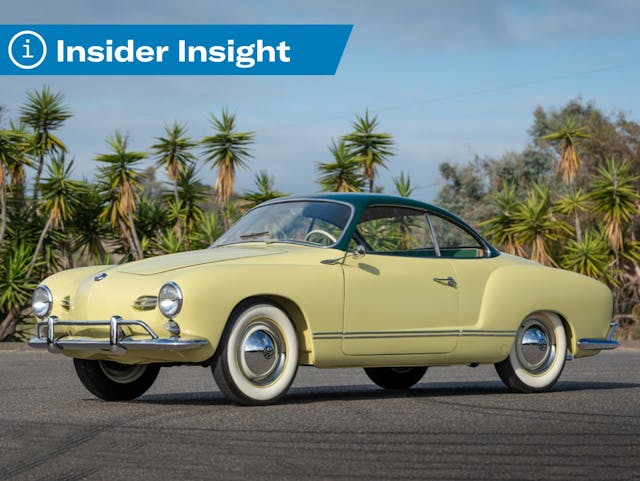Media | Articles
Why enthusiasts shouldn’t stress fall’s cooling market

We see the question all over forums, Facebook groups, and comments here on Insider: Is the car market pulling back?
It’s easy to point to sales that indicate “yes” (like the pair of water-cooled Porsches sold at Mecum Las Vegas) or no (such as Silverstone’s successful autumn auction).
Of course, the direction of any entire market is difficult to parse from a few transactions. Yet with classic cars there’s an additional challenge: No two are exactly alike. Even two 1969 Pontiac GTOs that rolled off the assembly line the same day are bound to have been equipped differently and then treated differently over the decades.
That can make it hard to discern when a sale indicates a market trend and when it says something about a specific car. For example, does a phenomenal result for one of those GTOs indicate that values are trending up for muscle cars … or was there just something special about that particular Goat?
That’s why, whenever possible—and especially at times when it’s unclear where the market is headed—we like to look at repeat sales. When a vehicle whose VIN we’ve recorded at one auction sells at another, we’re able to get an apples-to-apples comparison of price changes over time. Here’s what we’re seeing right now.
Marketplace
Buy and sell classics with confidence
Repeat sellers at auction have reserves; bidders increasingly have reservations
It should come as little surprise that repeat sellers have been making a killing this year. Overall average return increased from 1 percent in 2021 to 4 percent in 2022.
Digging deeper into the data, though, there are signs that bidders are starting to balk at those price hikes. The return for quick flips—cars bought the year prior and then resold—markedly declined in 2022, to 6 percent from 19 percent in 2021. And so far in 2022, repeat sales being offered with a reserve found a new owner 71 percent of the time. Not bad, but nearly 10 percentage points lower than last year.
We suspect buyers who previously bought online are now going back to the same platform, expecting the vehicle to sell again for what they paid or more, and are finding they have missed out on the bidding wars of the spring and summer. They might instead be fighting a war with a partner who is wondering why they still have the car they said they were selling.
There’s also a glass-half-full way to look at the no-sales: Sellers who have reserves don’t need to sell, which is an important sign of stability. If, at a certain point, enough sellers caved and let go of their cars at steep losses, we’d see a serious dip in values. But that’s not what we’re seeing.
In 2022, 80 percent of repeat sales at auction had a reserve. That’s basically the same as 2020 and 2021.
Stability at the top
Although repeat-sales data provides a more consistent view of the market over time than raw auction totals, it still has a major shortcoming: What sells one day is completely different than what sells the next.
Imagine trying to understand trends in food prices by tracking a fruit stand that sells apples one week, kiwi another. For that reason, it can be helpful to zoom in even closer, on repeat sales of a specific model.
Our favorite car for this purpose is the Mercedes-Benz 300SL. It appears frequently at auction and has consistent, easy-to-track chassis codes—not a given on pre-1981 vehicles.
And because the 300SL has been considered collectible for many decades (unlike, say, a Nissan Skyline GT-R or even an air-cooled Porsche 911), we can look at how repeat sales have fared over a long period.
https://datawrapper.dwcdn.net/VBPqI/6/
The latest updates to the 300SL repeat index unambiguously show the market has been cooling since January. That may sound odd given that other metrics, including overall auction sales, were going gangbusters at this time. Yet there is precedent: The 300SL index last peaked in 2013—about a year before the rest of the collector car market.
Yet the 300SL index’s 25-year history helps us put these gyrations in context. Over the past twenty-five years—a span that includes three recessions—Gullwing values have experienced ups and downs, but no wild nose dives.

There’s still plenty of appreciation on the private market
So far, we’ve been looking at repeat sales at auctions. That’s an important data set but also a relatively small one compared to the private market—that is, transactions among dealers and individuals.
Fortunately, we’re able to see repeat sales here via our insurance data. In 2022 alone, some 29,000 vehicles came off one customer’s policy and reappeared on another.
On average, the new owners are insuring their vehicles for 31 percent more than the previous owner. Yes, that’s a lot. It’s also one percentage point higher than in 2021, when the market was already pretty hot.
Mind you, many of these private-market repeat sales likely weren’t quick flips but rather had spent years with the previous owner.
But that, in and of itself, is telling. Whereas the microcosm of the auction world indicates softening demand, the bigger picture of the private market indicates that everyday enthusiasts—the ones who buy a car first and foremost for the enjoyment—are still winning big.
Check out the Hagerty Media homepage so you don’t miss a single story, or better yet, bookmark it.


